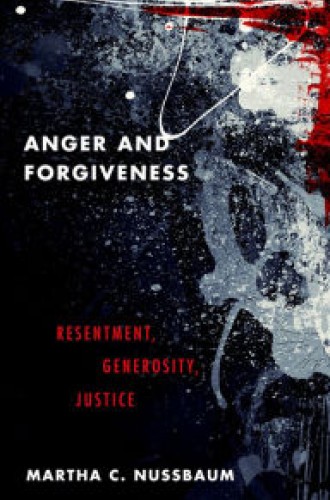Why we need anger
Martha Nussbaum has a problem with anger. In a nutshell, it is that such an emotion continues to exist. Anger and Forgiveness has a great many animadversions to make against the first of its titular themes, which its author believes to be an atavistic and almost entirely deplorable element in human evolution. Anger, Nussbaum asserts, “embodies an idea of payback or retribution that is primitive, and that makes no sense apart from magical thinking or narcissistic error.” While a fleeting moment of outrage—what she calls “transitional anger”—may be inevitable and even useful when one is confronted with injustice, it is necessary to move rapidly and decisively through this stage to a “forward-looking” stance. “All anger,” she declares bluntly, “is inappropriate.”
But that does not mean that its supposed opposite, forgiveness, is greatly to be preferred. The very worst kind of forgiveness, Nussbaum maintains, is the Christian form of “transactional” forgiveness, in which pardon is granted if the offender acknowledges fault and repents. To require a prior admission of wrongdoing is to compel the perpetrator to subject himself or herself to “a traumatic and profoundly intrusive process of self-denigration.”
Read our latest issue or browse back issues.
For Nussbaum, even unconditional forgiveness, offered as a free gift and involving no action whatever on the part of its beneficiary, is only a little less objectionable. “Unconditional forgiveness requires that the wronged party have angry feelings first, and then choose to waive them.” Thus tainted at its root, it is not so much an act of generosity as an ugly and “petty” display of self-righteousness on the victim’s part.
What is to be looked for instead, at both a personal and a societal level, is a response to an offense that is future-oriented rather than one that dwells on what cannot now be changed. “Mercy just gets on with things, looking to the next day. The past is past, now see that you don’t do this again—and also, let’s see how society can solve the problem better than this.”
Some passages of the New Testament, Nussbaum concedes, do not seem wholly consonant with this approach, notably Jesus’ stipulation that an erring brother is to be pardoned “if he repents,” as well as his driving-out of the money changers in the temple. With respect to the first, she sees no reason to accord “conditional forgiveness” any particular deference merely on account of its inclusion in scripture. As for the second, she prefers what she describes as the interpretation of the Utku Eskimo people of Nunavut, who interpret the violent expulsion of the money changers as a display of feigned anger on Jesus’ part for didactic purposes, a culturally attuned performance for an audience that would have been bewildered by a less spectacular manifestation of disapproval.
It’s difficult to know what to make of a book in which ex cathedra pronouncements and appeals to questionable empirical evidence feature as prominently as they do in this one. (Is it really true that “the rate of intimate partner violence is slightly higher in Italy than in Jordan”? I have no idea, but I am quite sure that Nussbaum does not either. The actual rate of intimate partner violence is unknowable, depending as it does both on victims’ willingness to report and on widely varying definitions of what the term means.) Two things, however, emerge clearly from this book.
The first is that the perspectives, and needs, of victims receive very short shrift in comparison to those of offenders. All too often, Nussbaum discusses the former in a manner that is brusquely insensitive, and sometimes considerably less even than that. A case in point is Nussbaum’s full-throated condemnation of victim impact statements, which, if I were discussing any other book, I might be tempted to say arouse the author’s anger. The best that can be said for them, she says, is that
in some cases they help victims move forward by satisfying their desire to tell their story. Well, fine, we should be all in favor of narration if it helps and does no harm. But . . . [w]e should not support victims in sating their desire for payback, with all its problems for fairness to the defendant. . . . [A] wise society will not build criminal law policy on what economist John Harsanyi has called “sadistic and malicious preferences.”
It is noteworthy that this passage was published one month to the day before a victim of sexual assault known only as “Emily Doe” presented her 7,000-word victim impact statement before a California court in what has become notorious as the “Stanford swimmer” case. That document, which has since been read in its entirety on the floor of the U.S. Congress, is unquestionably marked by anger; its attitude to forgiveness is definitely transactional, to the degree that it sees a place for it at all. It is at least open to question, however, whether it may not have served the interests of justice and fairness at least as well as anything Nussbaum recommends.
The second, and related, distinguishing element of the book is its reluctance to engage with, or perhaps even to admit, the problem of evil. Recourse to punishment even for serious offenses, Nussbaum argues, ought not to take priority over measures like “skills training, employment opportunities, and education” that might have prevented the crime from occurring in the first place. She is, however, silent about what is to be done about offenses and offenders that are not amenable to being addressed by these means. The term wrongdoing, she says, is to be preferred because it lacks “the overcharged valence of ‘evil.’” But there are surely crimes—against individuals, societies, and entire populations—for which even the most “overcharged” language is inadequate.
Speaking as a historian, it seems to me that there is one positive function of anger to which Nussbaum devotes insufficient attention. It is an antidote against forgetting things and people that both justice and morality require to be remembered. Neither the interests nor the perspectives of the offender and his or her victims are identical or even, in many cases, reconcilable, and in choosing what to mark and what to ignore, a society expresses its solidarity with one or the other. As Emily Doe reminded both her perpetrator and a criminal justice system for whom his future counted for much more than her past, a “forward-looking and non-angry spirit” can very often function as just another form of abuse.
A version of this article appears in the September 28 print edition under the title “Is anger necessary?”






